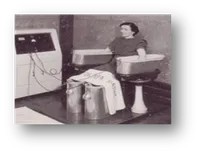Healing Cultures, Medicine and the Therapeutic Uses of Water in the English Midlands, 1840-1948
Professor Hilary Marland & Dr Jane Adams
This project explores the use of water in English medicine between 1840 and 1948, taking as a case study the English Midlands. It will challenge the assumption that spas declined in importance from the mid-19th century and highlight water’s role as a continued mainstay of a rich and varied spectrum of therapeutic approaches.
The study examines the complex process through which the water cure became increasingly medicalised, characterised by greater specialisation and a proliferation of medical institutions. These trends were influenced by an expanding medical marketplace in which a range of non-medical actors, including local authorities, mutual societies and private businesses, became increasingly active as services were targeted at specific publics, including the poor, the middle classes, women and the chronically ill. The importance of broader public and private cultures of health will also be examined, in particular how health and social reform movements and political and religious attitudes affected the patient’s view of the water cure. The project will, additionally, explore the relationship between the medical uses of water and wider social and cultural changes, including public health and hygienic campaigns, expanding domestic supplies and increased commodification of water.
The emphasis on the English Midlands provides a geographical bridge between old and new systems of healing with water, with the inclusion of both established watering places and new spas and hydropathic towns. The project will entail detailed comparative analysis of the traditional spa towns of Cheltenham, Leamington and Buxton, Malvern and Matlock with their booming hydropathic establishments, Droitwich (the only inland brine spa in Britain), and several smaller mineral spas (e.g. Woodhall and Tenbury Wells). During the period under review the region saw large-scale industrialisation, which opened up new market opportunities in terms of the growing working- and middle-class populations. The sites of water cures were presented as healing environments in contrast to polluted, unhealthy urban communities. Continuous efforts were made to update facilities and to develop state of the art therapeutics within strikingly different settings, from the subdued pleasures of genteel, urban Leamington and Cheltenham Spas to the rigorous natural backdrops of Malvern and Matlock. In a quest to mould an appropriate but distinctive image, each town offered a range of leisure activities and public amenities, leading to the creation of very different micro-environments.
The main outputs of the project include a monograph study, journal articles and public outreach activities, some of which will be developed with our collaborative partner, the Art Gallery and Museum, Royal Leamington Spa. Selected research findings will be summarised on the Centre for the History of Medicine website.
 |
Events
|
 |
Publications
|
 |
Conferences / Seminar Papers
|

Image courtesy of the Royal Pump Rooms and Museum, Leamington Spa.

